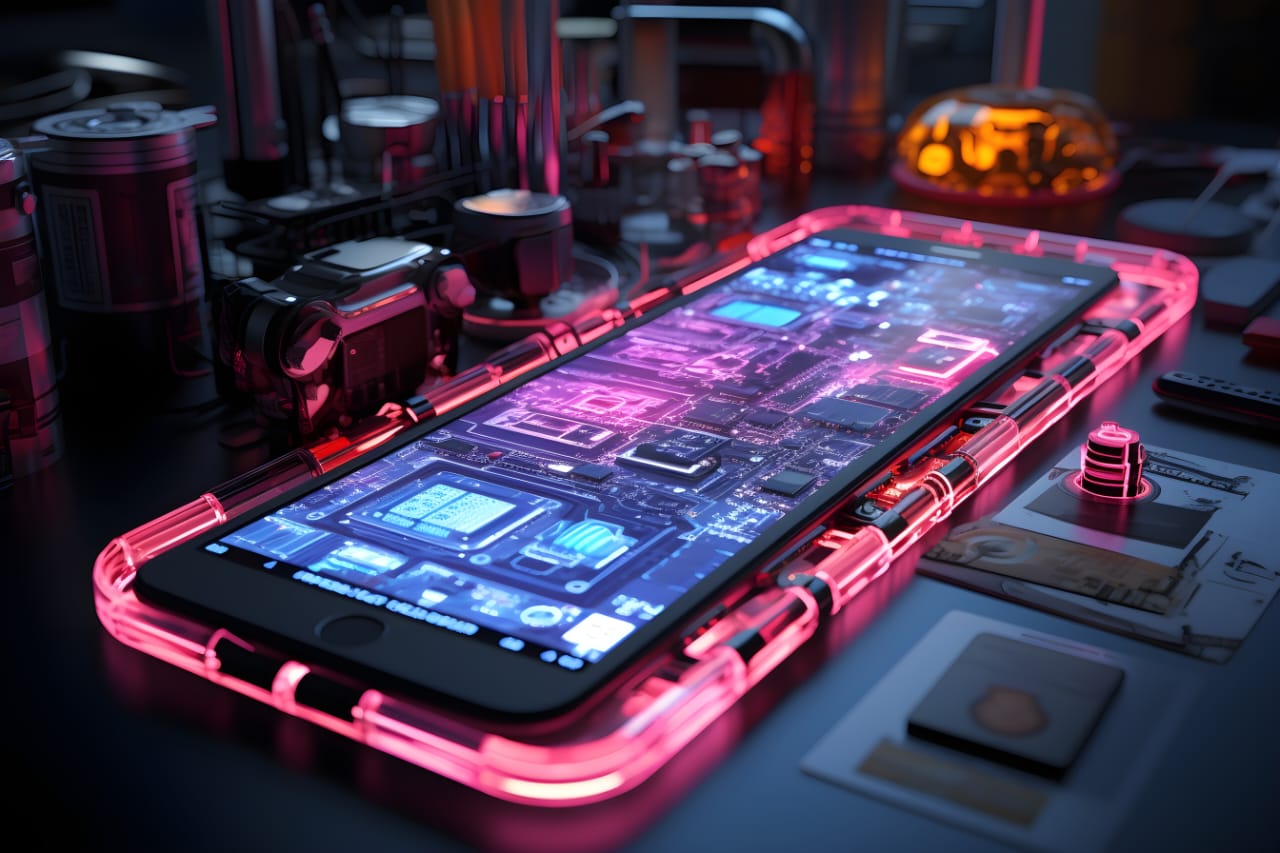Smartphones, a device that is no longer a strange thing for most people as it has gradually entered people’s everyday lives. Smartphones are mobile phones with computer capabilities and internet searching, the only difference may be the size and its mobility. In another word, it has become a source of entertainment, a communication tool, a search engine and much more. It has been decided to choose the smartphone industry as the main topic for this thesis. But the smartphone itself is not appealing enough because the smartphone is just another artificial object.
However, the brand and the owner are far more attractive. Same device, same features but each type has its own operating system which leads to different experience. Some are opened and everyone can use, some are closed which means a lot of privacy for users but not everyone can use it. Still, each brand has its own history, and it is the evolution of the history that is most fascinating. How the brand was born, what innovations it went through, what kind of strategies the company developed to compete with each other… all led to very different results.
To start, the thesis will give a quick look at the evolution of the mobile industry so that readers can better understand how it started, what stages it went through. The next chapter will deal with the modern form of mobile phone: the smartphone. In this article, the strategies of different brands will be revealed and compared. The fourth chapter is the results that lead to different fades for different brands. The final chapter is about the future generation of smartphones based on facts, analysis and expectations from users and expertise. And finally, the thesis will end with a survey to know more about the popularity of smartphone brands as well as users’ satisfaction with each brand.
1 History of Mobile Phones
March 10, 1876 is considered a milestone marking the arrival of the telephone. The father of the first telephone at first time in whole world was Alexander Graham Bell. The rudimentary machine could transmit voice, which replaced the telegraph and opened a new era of development in the history of communications. 1967, a handset called the Carry Phone, considered the first “mobile”, was released, however, the device was too cumbersome to move as it weighed 4.5 kilograms (Randy, 2011).
The mobile phone was officially launched on April 3, 1973 under the name Motorola Diana Tac, invented by inventor Martin Cooper. The size of the Motorola DynaTAC was similar to today’s mobile phones, although it was quite heavy with a weight of over 1 kg and was not popular (Richard, 2015). Since then, mobile phone development has continuously evolved and become more compact than its ancestors which were growing integrated and more functional rather than just texting and calling.
In 1991, second generation (2G) cellular technology was introduced. This was the slogan of Radiolinja, a Finnish company: “Finns can now call” (Biju and Naumann 2014). This tagline implies the limitation of the time of the first generation mobile phones. The period after 2001 is dominated by 3G technology. By the year 2009, the demand of mobile users is increasing and they require high quality and high speed, a prerequisite for the introduction of 4G technology. 4G has the advantage of speedy Internet access as well as faster application of advanced multimedia.
In 2008, it was estimated that there were only two people who owned a mobile phone. From 1990 to 2011, the number of mobile subscribers globally increased from 12.4 million to more than 6 billion subscribers. Not only the increase in the number of users, mobile phones also witnessed changes in design and functionality based on advanced technology. 1973 is a high priced phone, less features, bigger and heavier, but by 2013 – 40 years later – the phone was much cheaper, it is an essential device for anyone, smaller, lighter, thinner and more and more features.
2 The First Generation of Mobile Phones
The first smartphone came out 20 years ago, (date 11/26/1993) at the COMDEX fair in Las Vegas (USA), IBM launched a phone called IBM Simon, or also known by the code name Angler. Despite being a mobile phone, the size of this phone is equal to that of a Nexus 7 tablet today. With a weight of around 0.6 kg, it was easy to see that the user was not comfortable carrying it around. Equipped with a 16MHz processor speed, 1MB of RAM and 1MB of hard drive storage, much like smartphones today, the Simon was also equipped with a large touch screen 4.5-inch, stylus writing support. The Simon’s touch screen was monochrome and ran on ROMDOS – an Operating System variant of DOS. It was not very functional. It reflected early mobile technology (Julian, 2015). Although its features were simple, this device is of great importance to the evolution of smartphones.
In terms of features, the Simon can be used to make, send and receive calls and can even be used to send or receive faxes, something that today’s smartphones cannot do. In addition, it was equipped with applications such as address book, calendar, calculator, world clock, handwriting recognition on the touch screen. Users can download and install additional applications from third-party developers, similar to today’s smartphones. Although Simon was launched in 1992, it was not until 8/1994 that this smartphone was officially available in the market. At that time, the price of the product was not cheap at all with a 2-year contract with BellSouth Cellular Network (Andrew, 2012). However, it was undeniable that Simon is the pioneer of today’s smartphones, although at that time the concept of “smartphone” had not appeared premiere, however, the world has accepted that Simon was the first smartphone. Above all, Simon’s launch was a great example to show how quickly technology has evolved over the last 2 decades.
Palm was one of the names that brought forward the concept of smartphones. The first pilot devices 1000/5000 began in March 1996, when Apple launched the Newton Message Pad, which attracted attention, but was not a market success, for Palm (part of the U.S. robotics division at the time). Started marketing PDA (Personal Digital Assistant – Personal Accessories). The Pilot 1000 was sold for $299 USD with 128 KB of memory, along with 512 KB of memory. The Pilot 500 (369 USD) were the first two models to have a gray shell design, the same basic design of the current products. The pair had a screen resolution of 160 x 160 pixels, used the device with Windows (version 3.1 or 95) and two AAA batteries for a week or more of operation. But both of them no longer exist in the market and have become “antiques”, but they are the main characters who paved the way for the smartphone revolution (Yardana 2009).
In 1999: Ericsson R380 – the first smartphone was officially unveiled. R380 users did not need to carry multiple mobile devices as all these devices were encapsulated in this small phone. Through WAP services, Internet information is provided to more than 120 countries connected internationally across 5 continents. With this mobile phone, users can connect and work anytime, anywhere. With a touch screen and graphical richness, it provides organizational skills and personal interaction, and WAP services on the R380 enable users to receive or send email, or visit their Web sites or even get weather forecasts, flight information, and more. Get information about life in the form of news and sports news, traffic information … The R380 uses the Symbian operating system, a system specifically designed for wireless communication devices.
BlackBerry 5810 – Email and surfing capabilities were introduced in 2002. BlackBerry combined smartphone market with 5810 devices which allowed users to send email and surf the internet. Before RIM released a new line of phones running the BlackBerry 10 operating system, Sasha Segan, an expert on mobile devices, has reviewed the landmark models of this label, noting certain changes in functionality and design, not necessarily That most successful product, such as the Z10 was the BlackBerry’s first device, but it was not the most successful.
3. New Era of Smartphones
The original smartphone is said to have been in 2007 when Apple unveiled the IPhone. At that time, Android was growing and becoming one of the most attractive foundations… Android continues to expand; The platform received a lot of support from manufacturing. However, with the advent of the Apple iPhone, everything changes forever. From 2008 – 2012: Android dominates the smartphone market as the operating system most used for smart phones was Symbian, but at this point Google has introduced Android, an open source phone operating system that has been used throughout the Mobile phones dominate the market, not only for mobile phones but also for many other products. According to the information given by Google on 22/09/2012, more than 500 million Android devices are used every day (Arun 2013). Last but not least, Windows 8, Mobile Phones integrates cloud storage remotely. The goal is to keep your data in sync between the customer’s mobile and computer. According to predictions of technology experts, perhaps 2013 is the year of Windows Phone.
In today’s technological era, smartphones are not only growing in popularity, but also provide people with a series of new possibilities in all fields such as information exchange, mobile working, entertainment anytime, anywhere. According to a survey, the global smartphone audience crossed the 1 billion mark in 2012 and will total 1.75 billion in 2014. Experts expect smartphone adoption to continue on a fast-paced trajectory through 2017. By 2014, near two-fifths of the world’s population, or one-quarter of the world’s mobile phone users, will be using a smartphone at least once a month. It shows how pervasive smart phones are becoming and how inextricably infused they already are into life across the globe. By the end of the forecast period, smartphone penetration among mobile phone users globally will be near 50% (Greeshma 2014).
Read Also:
- Introduction To Mobile Phones
- Samsung Smart Phones
- Concept and History of Mobile Phones
- 20 Mobile Phone Uses and Features
- Adverse Effects and Probable Solutions of Mobile Phones

